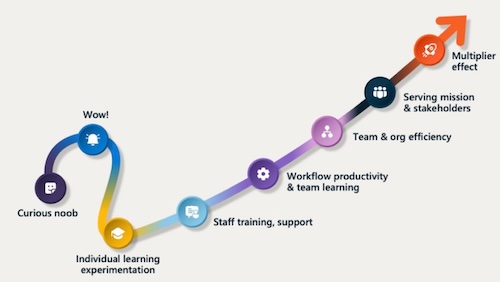👀Join me on February 22nd at 9:00 am PT for a LinkedIn Live with Zoe Amar for a conversation about taking the first step for responsible AI adoption.We’ll discuss the challenges, tips, and practical resources available.

Last month, at the Global Nonprofit Leaders Summit in Seattle hosted by Microsoft, I moderated a roundtable, “Empower Employees with AI Productivity Tools,” with leaders from three nonprofits: Alex Duncan,, British Heart Foundation; Jon Townsend, National Trust; and Joel Ramjohn, Agape Source. As early adopters, they shared valuable insights on the early stages of AI adoption for nonprofits.

The illustration above captures the full AI adoption journey for nonprofits that will take months to years to complete. It begins with learning, habituation, and cultural shifts to fully harness AI benefits responsibly. The path may seem daunting, but the key is to start with your people.
Understand staff concerns about AI changing their jobs
Jon Townsend, National Trust says that leaders should understand people’s anxiety about AI in the workplace as the very first step. It often revolves around job security, with fears of obsoletism due to “offloading” tasks to the AI. There’s also discomfort over the rapid pace of change and perceived steep learning curve while being overwhelmed with current workloads. Additionally, there’s worry about the impersonal nature of AI, which might diminish human interaction and decision-making in professional settings.
Some nonprofit staff members have expressed concerns about losing their sense of purpose.They anticipate that AI might reduce their job role to mere oversight of automated processes, stripping away the meaningful engagement that comes from hands-on creativity and a decline in job satisfaction.
The workplace research suggests some nonprofits jobs will change or be disrupted. Leaders should emphasize that “disrupt” doesn’t mean someone’s job will no longer be necessary. It means removing the busy work out of their hands so they turn their attention to more mission-critical work. AI cannot do someone’s job from A to Z, it is more of a joint effort known as “copiloting.” Humans and AI each do what they do best, with humans always in charge of the final product and division of tasks.
This is why it is important for leaders to encourage staff to reflect on their workflow processes and to encourage experimentation as described below. When staff are able to map out what the AI can do and what they can do, they get a view of their job role that they have never had before. It lessens the fear and it helps them focus on where these tools are useful and where they can become more useful, valuable to your nonprofit’s mission. It is also important to create feedback loops for staff to share their experience with others and provide professional development opportunities for those whose jobs tasks change and evolve.
Give Staff Time for Hands-On Discovery
Leaders should provide time for staff for hands-on exploration. Discovery can help them understand the benefits and the limitations as it applies to their specific work flows. It helps them cultivate essential human skills like adaptability, creativity, and problem-solving, which are invaluable in a world increasingly shaped by AI. Experimentation should feel like playful, be fun and create a sense of wonder.
Unlike other types of technology, generative AI is easy to use, as simple as typing in a question or what is called a prompt.Until people put their hands on the technology, they may have a misconception that they have to be technically savvy or know how to code to become skilled in copiloting. Or they may feel they have to use AI for all job tasks to be productive, another false impression. AI is more like hot sauce, you can use it sparingly.
During our panel, Joel Ramjohn from Agape Source illustrated the power of playful experimentation with AI. He described how volunteers, previously spending hours on research for culturally resonant welcome baskets, turned to Copilot for quicker insights. By simply asking, “What food items would be meaningful as a gift to someone from XYZ country?” They made it a game first, using locations that they all knew really well. When they applied it to their actual work task, they realized they could design personalized gift baskets in minutes, not hours.
Apply in Low Risk Ways to Work Flows
Now it is time to learn prompting skills applied to different job tasks. Staff should be encouraged to think about day-to-day tasks in their job, especially ones that they find time consuming or difficult. For example, a marketing coordinator may identify tasks such as writing a first draft for content, or analyzing hundreds of open-ended survey comments.
Encourage staff to look for “points of pain” where busy work, known as the “digital debt” – processing endless emails, managing back-to-back meetings zaps people’s energy or reformatting information and robs time away from strategic thinking. Applying AI to basic collaboration workflows can offer a dividend of time (and brain space). During our panel, Alex Duncan, British Heart Foundation, mentioned that they were able to analyze the time savings for staff in various tasks such as managing meetings, processing email, writing drafts, summarizing long reports, or analyzing data as saving 45 minutes per day.
The most important skill staff can learn from this activity is to know when to use AI and when to use human skills. This process begins with learning technical skills such as “prompting,” which involves constructing the right questions to ask generative AI tools in order to get useful answers.
Staff also need to learn the limitations in using these tools for these types of tasks and how to ensure responsible use. These steps include auditing the output for accuracy and mistakes; understanding that the AI can generate a good first draft, about 80% of the work, but the humans must complete it; and understand what information should not be shared, like personally identifiable information or confidential documents, if using public models.
Nonprofit leaders must be intentional and thoughtful about taking the first steps to AI adoption. It must a people-first orientation, focusing on listening to staff concerns, creating safe spaces and time for them to discover, and apply the technology in their own way. By being human-centered, it ensures AI adoption is aligned with the organization’s core values and exponentially multiply impact.

Leave a Reply